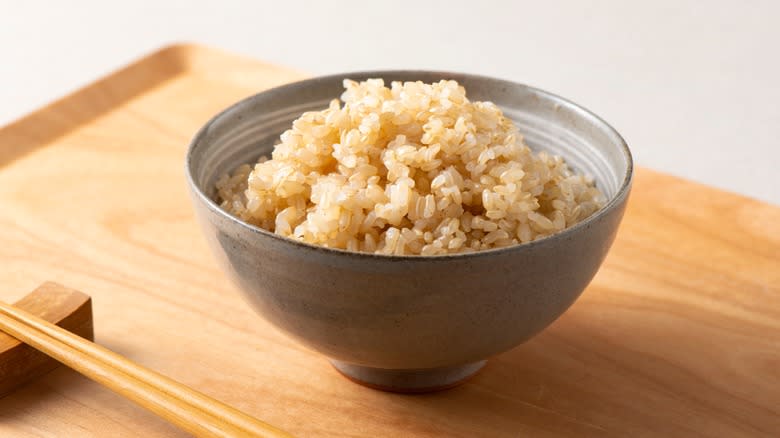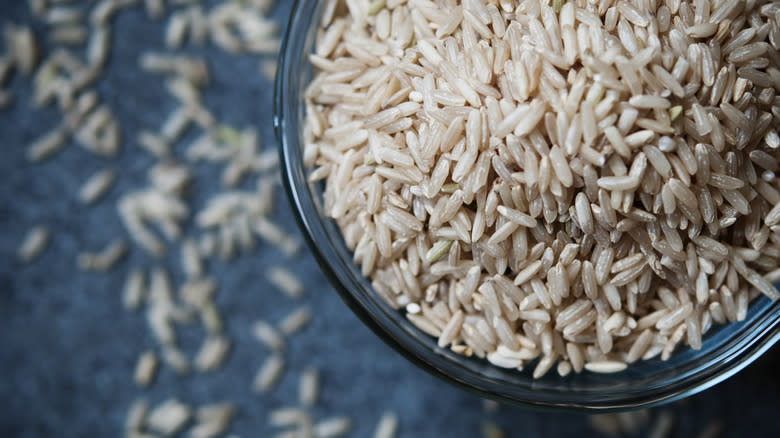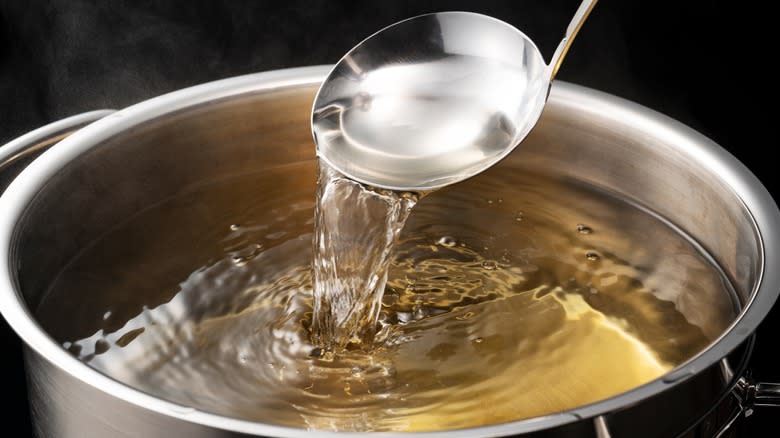The Top Tip For Avoiding Undercooked Brown Rice

Brown rice of every description -- from basmati to genmai -- is beautiful. A nuttier, more nutritious version of its white counterpart, brown rice tastes incredible and pairs wonderfully, and sometimes even better, with many dishes than white rice. Still, some home cooks avoid making it because of the extended cooking time, and also because of the perceived difficulty in achieving a result that's neither undercooked and chewy, nor a gluey mass. Your best bet is to start by reading the instructions: Not all brown rice is created equal, so the water-to-rice ratios, as well as the recommended cooking times, might differ from one kind to another, and are worlds away from white rice. If you're still unconvinced, we've got a hint: Using the pasta method for cooking brown rice is usually foolproof.
The pasta method involves simmering rinsed rice grains in a lot of water (about five times the amount of rice) in an uncovered pot for the recommended cooking time, then removing a few grains to check for doneness. Still gummy? Keep going. Perfectly cooked? Drain the rice and steam. Using the pasta method, you're guaranteed to get not only properly cooked brown rice but perfectly individuated grains as well.
Read more: 13 Tips To Make Your Shrimp Taste So Much Better
What Is Brown Rice, And Why Cook It Like Pasta?

All rice grains are hulled because the hull is inedible. This process leaves the brown bran around the white germ, which is often removed to give us white rice. The bran is edible, and it's a good source of fiber, nutrients, minerals, antioxidants, and vitamins, according to Healthline. Brown rice has more health benefits still: where the carbohydrates of white rice may not be great for people with diabetes, the sugars in brown rice are released into the body much more slowly. Its high fiber content also is ideal for maintaining heart health. So, now that we understand the healthy benefits of adding brown rice to our diets, let's look at why the pasta cooking method works for it, and not its white counterparts.
The answer is that brown rice is so robust. It's one thing to make risotto in an open, uncovered pot with arborio because you're looking for an undifferentiated result. But if you tried boiling a delicate, starchy white rice like jasmine in an open pot, you'd end up with gruel. The presence of the bran allows brown rice grains to hold their shape during the open-pot cooking method, as it takes them, on average, three to four times longer to absorb the requisite amount of water to cook.
Cooking Brown Rice The Pasta Way

If the pasta-cooking option is the thing that convinces you to try making brown rice at home, we should discuss that in more detail. Let's say the cooking directions on the rice package call for one part rice to two parts water, and you would like to cook ½ cup of rice. Instead of steaming the brown rice with 1 cup of water or broth in a covered sauce pan, instead put 5 cups of liquid into a large enough pot and bring to a boil. (As with pasta, we recommend salting the water. You might want to add a little fat, too, in the form of olive oil, butter, or ghee.) Rinse the dry rice thoroughly, then add to the pot once the cooking liquid boils.
Follow the recommended cooking time -- typically 40 minutes for brown rice. Remove a few grains with a slotted spoon, let cool, and taste. Once the rice is properly cooked, drain the pot and let the rice steam off heat, covered, for 10 minutes. You should have a perfect batch of brown rice, and your kitchen will smell wonderful.
Read the original article on Daily Meal.

